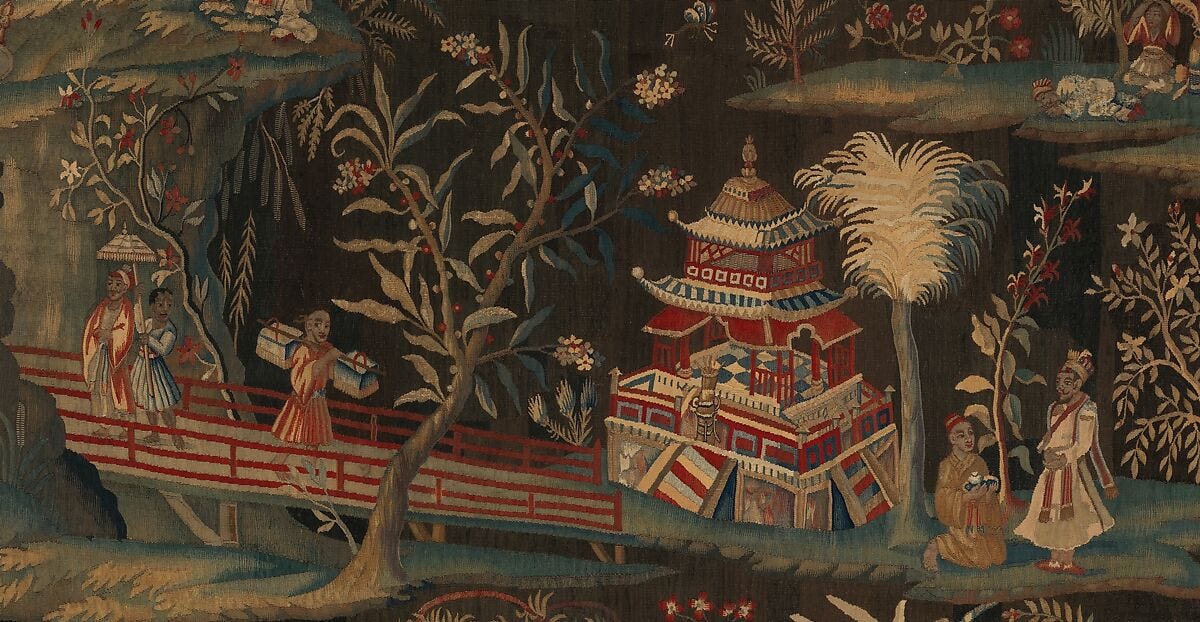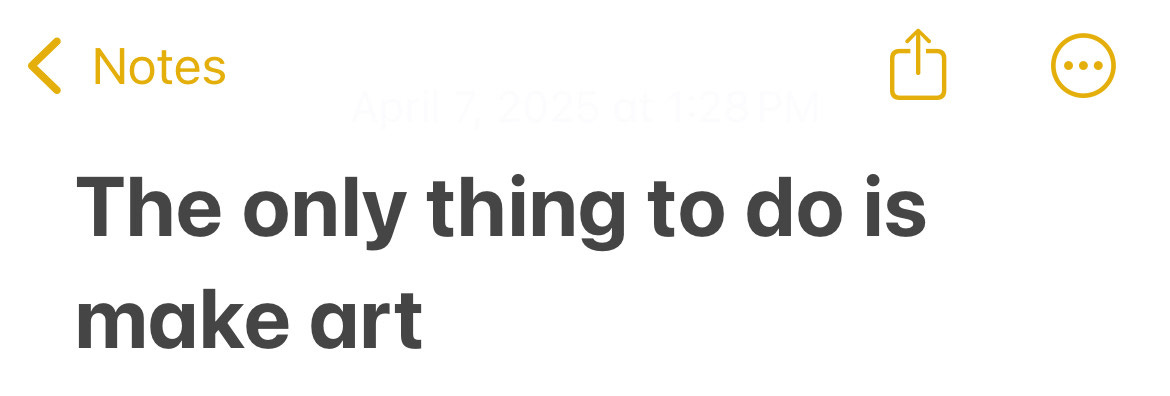I took the train uptown on a rainy morning several weeks ago to visit the Met. The obvious draw for me was ‘Floridas,’ a joint exhibit of photographs and paintings of Florida by Walker Evans and Anastasia Samoylova, but I was also curious about ‘Monstrous Beauty,’ an exhibit described as a ‘[radical reimagining] of the story of European porcelain through a feminist lens.’1
I expected to feel moved by ‘Floridas,’ and I was. Every work of art in that room made me miss or mourn for my home state (and renewed my desire to do a Florida road trip one of these days!). But I was even more moved by Monstrous Beauty, which included embroidery and tapestries in addition to the porcelain and ceramic objects. I was particularly struck by the woven work, perhaps because of my experience with (much more simplistic!) fabric-based art. There were two pieces in particular that I lingered on: an embroidered mirror frame, and a tapestry.


The Tapestry, titled “The Toilette of the Princess” and attributed only to “Various artists” was over ten feet tall and thirteen feet across. From across the room, it was merely an intricate tableau, but standing inches away, close enough to see every thread, it was awe-inspiring. I was as impressed by the effort as I was by the final product.

The next day, I went to my friend Lynn’s event, a reading to celebrate the release of her fourth (!) novel. As I listened to her answer questions about craft, I realized that this was yet another acknowledgment and display of effort—someone who has both publicly and privately dedicated a significant amount of time to reading, talking about books, and writing. Listening to her speak made me excited to recommit to the unfinished manuscript I began early last year.
Not only did these experiences renew my creative drive, they also pulled me out of the spiral of ‘effortlessness’ that I occasionally find myself caught up in.
If you spend any time on the Fashion Internet, you have likely found yourself in the effortlessness vortex at some point. There are hundreds—maybe thousands—of articles, posts, YouTube videos, on how to look ‘effortless’. You see it in the cult of Carolyn Bessette-Kennedy devotees2, the veneration of Joan Didion and her packing list3, the resurgence of 1990s-era Calvin Klein minimalism, the endless scroll of images from a Pinterest search for ‘effortless style.’ So what makes effortlessness desirable in regard to fashion?4
In many art forms, visible effort is often a point of pride. Layers of paint clinging to canvas imply time spent in the studio; the crisp grain of a photograph alludes to hours in the darkroom. I’m in the middle of a book right now that exists purely because of curiosity around effort and process: The Work of Art by Adam Moss, a compendium of interviews, ephemera, and behind the scenes snippets from over forty artists and writers. It’s a welcome counter to the assumption that a finished product always comes easily.
An interest in fashion and style is often belittled or dismissed as superficial, even more so than other creative pursuits that women engage in.5 And when your passions are characterized as frivolous and shallow, it’s a natural response to want to hide that effort, to avoid judgment for spending your time and energy on something not perceived as a valid avenue of creative expression. We valorize innate ability so as not to be seen expending effort—or worse, taking joy in it.6
I see and admire the visible effort in the creative pursuits of everyone I know. I watch my friend Kristin mix paint, using a palette knife to spread it and sharpen her edges, repainting an area of the canvas if the color isn’t working the way she thought it would. I watch my friend Kara painstakingly appliqué letters onto a quilt top, which will require two more additional techniques (quilting and binding) before it is finished. I work on my own quilts, piecing together dozens of scraps of fabric, hand-sewing the binding with an invisible stitch, folding corners to get the perfect mitered edges.
My interest in style is no different—I see it as an extension of myself, a creative output. And I spend time and effort cultivating and evolving that interest. I consume media focused on it—both current writing (newsletters, print magazines, the larger internet) and longer historical works, like Pockets by Hannah Carlson, Dress Codes by Richard Thompson Ford, Worn by Sofi Thanhauser. Style is one of the lenses through which I analyze my world, and my life is much richer for it. So why demur, dismiss or diminish my intentional choices, act as though I ‘just threw this on’ (though that is often untrue!) when I receive a compliment?7
What I wear is usually calibrated carefully to my day, dependent on occasion or situation. I base my outfits on a myriad of different factors—not only basic facts like where I’m going or what the weather will be like, but more nuanced considerations. Is there a dress code, and if so, how closely do I want to adhere to it? What is the symbolism of a particular color or pattern in this particular space?8 Am I in a space where wealth and status are valuable currencies, and if so, do I want to telegraph that I belong by wearing an expensive or status-signaling item, or reject that framework entirely? Will I have a story to tell if someone asks me about a certain piece? Will this item signal my knowledge and familiarity with the people and spaces around me, or will it establish me as an outsider?
My best outfits are rarely the ones I just throw on. Why shouldn’t I acknowledge the effort that goes into getting dressed—and the joy I derive from that effort?
While researching this piece, I came across this post by Zara Wong that explores this same topic in a really thoughtful way, and explains that there have been just as many moments in the history of art where effort was not considered desirable. You should read it!
I am aware that plenty of pursuits that were formerly denigrated as frivolous women’s work are now considered artwork and hanging on the walls in famous museums!
Someone who counters this perfectly is Rachel Solomon of
, whose bio reads, “I don't have innate style. I learn. And help others learn too. Let's find the joy in getting dressed every day.”This feels related to the millennial pathology of minimizing any accomplishment by announcing, “I did a thing!”
Anyone who has accidentally worn the opposing team’s colors to a sporting event will recognize the importance of this question!











Loved this piece. “Effortless” also has an insidiously pressurizing effect on how we feel about how we cook, and how we invite others to join us at the table. Even something as potentially simple as having friends over for dinner can feel so scary when we're bombarded by messages that imply we should already know how to do this. Both cooking and hosting are much harder when you’re told that "effortless cooking" and "effortless entertaining" are an actual thing that other people are doing. There’s a cognitive dissonance: How am I looking at a beautiful, photo worthy spread of food and simultaneously being told that it’s actually low lift and easy? Maybe it's easy if you already have the cooking skills, the beautiful dining room, and free time. OR - What if the effort — even if we find ways of making it more manageable — is actually part of the point? Part of how we show that we care about the people we’re feeding/hosting? Much to think about!
This was so very, very good Eleanor. I love the way you contrasted the fact that we appreciate the effort of other arts but want to diminish style as needing effort because it feels frivolous. I have been quietly bucking that notion in my own life by owning the fact that I really care what I wear and what that communicates (as you said; considering the time and place of what I’m dressing for).
I’m bothered by the idea of “effortless” dressing because most women who care about clothes know that it’s BS so why do we continue the façade? It’s almost like when we compliment each other’s outfits, the response should be “thanks, I really thought about this one.”